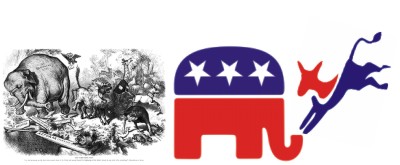Feature
America Votes 2008
Story of Donkey & Elephant
Mahmud-Ur-Rashid
 THE Republican Party and The Democratic Party, two major contemporary political parties in the United States of America have mascots having interesting origin. THE Republican Party and The Democratic Party, two major contemporary political parties in the United States of America have mascots having interesting origin.
The Republican Party often referred to as the Grand Old Party or the GOP. Founded in 1854 it first came to power in 1860 with the election of Abraham Lincoln to the presidency. We all know, the party's nominee for President in the upcoming 2008 election is Senator John McCain
The Democratic Party is the oldest political party with the record of continuous operation in the United States and it is one of the oldest political parties in the world, founded by Thomas Jefferson, James Madison, and other influential opponents of the Federalists in 1792. This year, the party's nominee for President Election is Senator Barack Obama
The mascot for Democratic Party is Donkey and that of Republican Party is Elephant. When Andrew Jackson ran for president in 1828, his opponents tried to label him a "jackass" for his populist views and his slogan, "Let the people rule." Jackson, however, picked up on their name calling and turned it to his own advantage by using the donkey on his campaign posters. During his presidency, the donkey was used to represent Jackson's stubbornness when he vetoed re-chartering the National Bank.
Interestingly enough, the person credited with getting the donkey widely accepted as the Democratic Party's symbol probably had no knowledge of the prior associations. Thomas Nast, a famous political cartoonist, came to the United States with his parents in 1840 when he was six. He first used the donkey in an 1870 Harper's weekly cartoon to represent the "Copperhead Press" kicking a dead lion, symbolizing Lincoln's Secretary of War, Edwin M. Stanton, who has recently died. Nast intended the donkey to represent an anti-war faction with whom he disagreed, but the symbol caught the public's fancy and the cartoonist continued using it.
Later, Nast used the donkey to portray what he called "Caesarism" showing the alleged Democratic uneasiness over a possible third term for Ulysses S. Grant. In conjunction with this issue, Nast helped associate the elephant with the Republican Party. Although the elephant was connected with the Republican Party in cartoons that appeared in 1860 and 1872, it was Nast's cartoon in 1874 published by Harper's Weekly that made the pachyderm stick as the Republican's symbol. A cartoon titled "The Third Term Panic," showed animals representing various issues running away from a donkey wearing a lion's skin tagged "Caesarism." The elephant labeled “The Republican Vote," was about to run into a pit containing inflation, chaos, repudiation, etc.
By 1880 the donkey was well established as a mascot for the Democratic Party. A cartoon about the Garfield-Hancock campaign in the New York Daily Graphic showed the Democratic candidate mounted on a donkey, leading a procession of crusaders.
Over the years, the donkey and the elephant have become the accepted symbols of the Democratic and Republican parties. Although the Democrats have never officially adopted the donkey as a party symbol, but used various donkey designs on publications over the years. The Republicans have actually adopted the elephant as their official symbol and used it widely.
The Democrats think of the elephant as bungling, stupid, pompous and conservative, but the Republicans think it is dignified, strong and intelligent. On the other hand, the Republicans regard the donkey as stubborn, silly and ridiculous but the Democrats claim it is humble, homely, smart, courageous and loveable.
After the 2000 election, the color red became associated with the GOP, although it has not been officially adopted by the party. That election night, for the first time, all of the major broadcast networks used the same color scheme for the electoral map: states won by Republican nominee George W. Bush were colored red, and states won by Democratic nominee Al Gore were colored blue. Although the assignation of colors to political parties is unofficial and informal, they have come to be widely recognized by the media and the public to represent the respective political parties.
(Mahmud2saber@yahoo.com)
|
